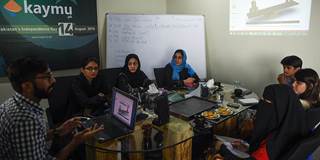Pakistan’s new government is understandably preoccupied with short-term economic problems, but it must also lay the foundations for a more inclusive long-term growth model. If it succeeds, the Pakistani economy might finally start to meet the rising aspirations of the country's young population.
ISLAMABAD – Last year, Pakistan witnessed the second successful democratic transition in its 71-year history, with Prime Minister Imran Khan taking office after his party won the general election on an anti-corruption slogan. Hopes are high for the new administration, which seems willing to work with both technocrats and opposition parties to address Pakistan’s many urgent challenges.
But the government faces a daunting economic agenda. In addition to restoring economic stability, it also must develop a bold plan for inclusive, sustainable long-term growth.
The current situation is not very encouraging. Foreign-exchange reserves fell sharply in 2018 as exports stagnated and imports rose rapidly. What’s more, the government had to borrow heavily to finance the growing fiscal deficit, which was caused in part by losses at public-sector enterprises and energy companies. Not surprisingly, the Pakistani rupee fell and inflation ticked upward. With tighter monetary policy and lower public-sector development spending also dampening demand, GDP growth in 2019 is projected to fall below 5%. Equally concerning are the debt repayments that fall due during this fiscal year.

ISLAMABAD – Last year, Pakistan witnessed the second successful democratic transition in its 71-year history, with Prime Minister Imran Khan taking office after his party won the general election on an anti-corruption slogan. Hopes are high for the new administration, which seems willing to work with both technocrats and opposition parties to address Pakistan’s many urgent challenges.
But the government faces a daunting economic agenda. In addition to restoring economic stability, it also must develop a bold plan for inclusive, sustainable long-term growth.
The current situation is not very encouraging. Foreign-exchange reserves fell sharply in 2018 as exports stagnated and imports rose rapidly. What’s more, the government had to borrow heavily to finance the growing fiscal deficit, which was caused in part by losses at public-sector enterprises and energy companies. Not surprisingly, the Pakistani rupee fell and inflation ticked upward. With tighter monetary policy and lower public-sector development spending also dampening demand, GDP growth in 2019 is projected to fall below 5%. Equally concerning are the debt repayments that fall due during this fiscal year.